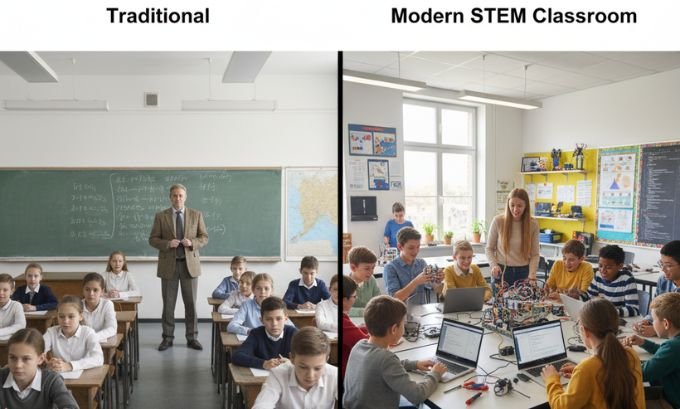STEM education means teaching Science, Technology, Engineering, and Mathematics in a way that connects them to real life. It moves beyond separate subjects to an integrated, hands-on approach where students learn by doing. This method focuses on problem-solving, critical thinking, and preparing students for the future.
Table of Contents
Understanding the Core Meaning of STEM Education
The true STEM education meaning is about integration. It’s an educational philosophy that combines Science, Technology, Engineering, and Mathematics into a single, cohesive learning model. Instead of teaching math in one class and science in another, Integrated STEM Education shows how these fields work together to solve real-world problems. This approach helps students see the practical value of their studies and develops skills essential for future success.
The push for this educational model isn’t new. For decades, organizations like the National Science Foundation (NSF) and the American Association for the Advancement of Science (AAAS) have highlighted the need to strengthen how these subjects are taught. The goal is to nurture curiosity and innovation from a young age, ensuring that students are not just memorizing facts but are learning to think like scientists, engineers, and innovators.
From Acronym to Educational Movement
The term STEM itself has an interesting history. While the push to improve science and math education has roots going back decades, the acronym we know today was popularized around 2001. Judith A. Ramaley, then a director at the National Science Foundation (NSF), is widely credited with coining the term. The NSF’s adoption of the acronym helped unify various educational reform efforts under a single, recognizable banner.
Before this, similar initiatives existed, but lacked a common identity. The NSF’s formal definition of STEM fields gave policymakers, educators, and researchers a shared language. This helped focus national attention and resources on improving education in these critical areas, setting the stage for a nationwide movement aimed at boosting America’s global competitiveness.
The “Why” Behind STEM: A National Priority
The emphasis on STEM is driven by a recognized need. Influential reports like Rising Above the Gathering Storm, published by a committee under the National Research Council (NRC), sounded an alarm. The report argued that the United States’ future economic prosperity and security depended on its ability to innovate and compete globally. It highlighted a gap between the skills students were graduating with and the demands of the 21st-century workforce.
This report, along with others, created a sense of urgency. It became clear that to maintain its leadership role and drive innovation, the nation needed a workforce well-versed in STEM. This led to increased federal funding and policy initiatives focused on transforming K-12 education to better prepare students for careers in these high-demand fields. Initiatives like Project 2061 by the AAAS were already working toward science literacy for all Americans, and the new focus on STEM amplified these efforts.
My Experience: Seeing STEM Education in Action
As an educator and curriculum consultant for over a decade, I’ve witnessed the shift towards STEM firsthand. I remember visiting a middle school that was struggling with student engagement in traditional science and math classes. The lessons were textbook-driven, and students couldn’t see the connection to their lives.

The school decided to pilot an Integrated STEM Education program. I worked with a team of 7th-grade teachers to design a project-based learning unit. The challenge for students was to design and build a small-scale water filtration system for a hypothetical community facing a water crisis.
Here’s how the disciplines were integrated:
- Science: Students researched contaminants and the chemical and biological principles of water purification.
- Technology: They used online simulation software to model their filter designs and created presentations to pitch their ideas.
- Engineering: They followed the engineering design process—ask, imagine, plan, create, and improve—to build their prototypes using everyday materials like gravel, sand, cotton, and charcoal.
- Mathematics: They calculated flow rates, material volumes, and cost-effectiveness for their designs.
The change was remarkable. Students who were previously disengaged were now leading discussions, collaborating on designs, and staying after school to perfect their prototypes. They were not just learning; they were problem-solving. This project brought the STEM education meaning to life for them and for me. It showed that when learning is hands-on and relevant, it becomes powerful.
What I Like / Strengths of the STEM Approach
- Fosters Critical Thinking: It teaches students how to think, not just what to think.
- Builds Resilience: The trial-and-error nature of projects teaches students to learn from failure and persevere.
- Promotes Collaboration: STEM projects are often team-based, developing essential communication and teamwork skills.
- Connects to Real-World Careers: It gives students a clearer picture of what scientists, engineers, and tech professionals actually do.
- Sparks Lifelong Curiosity: By making learning fun and relevant, it encourages students to ask questions and explore their interests.
If you’d like to explore this topic further, feel free to visit the following sites for more in-depth resources and insights
gogonihon.jp.net
mumbaitimes.net
mindjournal.co
Areas for Improvement
- Teacher Training: Not all teachers are equipped to teach in an integrated manner. More professional development is crucial.
- Resource Inequality: Schools in lower-income areas may lack the funding for technology, materials, and specialized staff.
- Standardized Testing Pressures: The focus on standardized tests can sometimes discourage teachers from adopting project-based learning, which takes more time.
- Overemphasis on “T” and “E”: Sometimes, the Science and Math components can be overshadowed by the more “hands-on” Technology and Engineering parts. A better balance is needed.
Siloed vs. Integrated STEM: A Comparison

The core of the STEM education meaning lies in its integrated approach. Here is a simple breakdown of how it differs from traditional, siloed education.
| Feature | Traditional (Siloed) Education | Integrated STEM Education |
|---|---|---|
| Structure | Subjects are taught separately. | Subjects are interwoven around a central theme or problem. |
| Learning Style | Primarily lecture-based and theoretical. | Hands-on, project-based, and experiential. |
| Teacher’s Role | Instructor who delivers information. | Facilitator who guides student inquiry. |
| Student’s Role | Passive recipient of knowledge. | Active participant and problem-solver. |
| Assessment | Based on tests and memorization. | Based on project outcomes, portfolios, and skill application. |
| Real-World Link | Often abstract and disconnected. | Directly linked to real-world challenges and careers. |
The Broader Impact: STEM and Global Competitiveness
The focus on STEM education is not just about creating better students; it’s a national strategy for securing global competitiveness. Countries that lead in innovation and technology tend to have stronger economies and a higher quality of life. The skills developed through a robust STEM curriculum—problem-solving, data analysis, and technical literacy—are the bedrock of a modern, knowledge-based economy.

Organizations like the National Research Council (NRC) have consistently linked a strong STEM workforce to national security and economic vitality. As technology continues to advance at a rapid pace, the demand for STEM professionals will only grow. By investing in K-12 Education with a STEM focus, we are investing in the next generation of innovators who will solve the major challenges of tomorrow, from climate change and disease to cybersecurity and sustainable energy. The efforts of the AAAS through initiatives like Project 2061 aim to ensure that this foundation is built early and for everyone.
Frequently Asked Questions (FAQ)
1. What does STEM stand for?
STEM is an acronym that stands for Science, Technology, Engineering, and Mathematics.
2. What is the main goal of STEM education?
The main goal is to prepare students for a world that increasingly demands skills in problem-solving, critical thinking, and innovation. It bridges the gap between classroom learning and real-world application, fostering a deeper understanding of how these disciplines work together.
3. Is STEM only for students who want to be scientists or engineers?
No. While it provides a strong foundation for those careers, the skills learned through STEM—such as critical analysis, collaboration, and creative problem-solving—are valuable in any profession. The STEM education meaning is about creating well-rounded, capable thinkers.
4. How is STEM different from a traditional science or math class?
A traditional class usually teaches a subject in isolation. Integrated STEM Education combines multiple subjects to solve a single problem. For example, a project might involve using math to design something (Engineering), testing it with scientific principles, and using technology to analyze the results.
5. When was the term STEM first used?
The acronym STEM was popularized around 2001. Judith A. Ramaley, a biologist and former director at the National Science Foundation (NSF), is credited with championing the term to describe the integrated curriculum.
6. Why is there such a big focus on K-12 STEM education?
Experts believe that introducing STEM concepts early in K-12 Education is crucial for building a strong foundation. It sparks curiosity at a young age and helps students develop a positive attitude toward subjects they might otherwise find intimidating.
7. How does STEM education relate to global competitiveness?
A nation’s ability to innovate and lead in technology is directly tied to its global competitiveness. By producing a skilled STEM workforce, a country can drive economic growth, create high-wage jobs, and solve complex global challenges, as outlined in reports like Rising Above the Gathering Storm.
Conclusion: More Than Just an Acronym
The STEM education meaning goes far beyond its four letters. It represents a fundamental shift in how we approach learning—moving from passive memorization to active creation. It is a response to the clear need for a new generation of thinkers, collaborators, and problem-solvers.
By embracing an Integrated STEM Education framework, we equip students with the tools they need to not only succeed in their careers but also to build a better, more innovative future. The work of organizations like the NSF and AAAS, and the insights from influential reports, have laid the groundwork. Now, the challenge is to implement this vision effectively in every classroom, ensuring every child has the opportunity to become a creator and innovator.
Interested in seeing how STEM can be applied in your local school or community? Start by exploring project-based learning resources or volunteering for a science fair.

